Related Research Articles

Murano is a series of islands linked by bridges in the Venetian Lagoon, northern Italy. It lies about 1.5 km (1 mi) north of Venice and measures about 1.5 km (1 mi) across with a population of just over 5,000. It is famous for its glass making. It was once an independent comune, but is now a frazione of the comune of Venice.

Cannaregio is the northernmost of the six historic sestieri (districts) of Venice. It is the second largest sestiere by land area and the largest by population, with 13,169 people as of 2007.
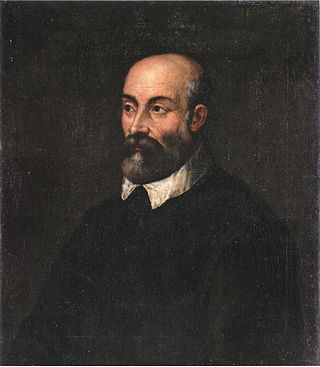
Andrea Palladio was an Italian Renaissance architect active in the Venetian Republic. Palladio, influenced by Roman and Greek architecture, primarily Vitruvius, is widely considered to be one of the most influential individuals in the history of architecture. While he designed churches and palaces, he was best known for country houses and villas. His teachings, summarized in the architectural treatise, The Four Books of Architecture, gained him wide recognition.

The Grand Canal is the largest channel in Venice, Italy, forming one of the major water-traffic corridors in the city.

Michele Sanmicheli, sometimes also transcribed as Sammicheli, Sanmichele or Sammichele, was an Italian architect and urban planner who was a citizen of the Republic of Venice.

Palazzo Labia is a baroque palace in Venice, Italy. Built in the 17th–18th century, it is one of the last great palazzi of Venice. Little known outside of Italy, it is most notable for the remarkable frescoed ballroom painted 1746–47 by Giovanni Battista Tiepolo, with decorative works in trompe-l'œil by Gerolamo Mengozzi-Colonna.
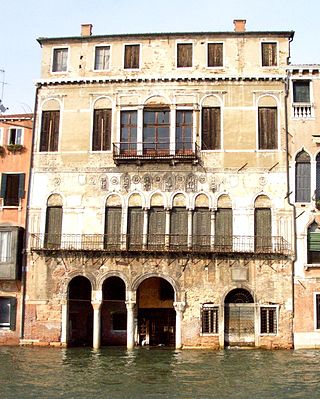
The Ca' da Mosto is a 13th-century Venetian-Byzantine style palace, the oldest on the Grand Canal, located between the Rio dei Santi Apostoli and the Palazzo Bollani Erizzo, in the sestiere of Cannaregio in Venice, Italy. Today, it is home to the Venice Venice Hotel.

The Museo Correr is a museum in Venice, northern Italy. Located in St. Mark's Square, Venice, it is one of the 11 civic museums run by the Fondazione Musei Civici di Venezia. The museum extends along the southside of the square on the upper floors of the Procuratorie Nuove. With its rich and varied collections, the Museo Correr covers both the art and history of Venice.

The Fondaco dei Turchi is a Veneto-Gothic style palazzo, later on named as the Turks' Inn, on the Grand Canal of Venice, northeast Italy.

The Palazzo Grimani di San Luca is a Renaissance-style palace, located between the Palazzo Corner Valmarana and the Rio di San Luca and the flanking Palazzo Corner Contarini dei Cavalli on the Grand Canal in the sestiere of San Marco of the city of Venice, Italy.
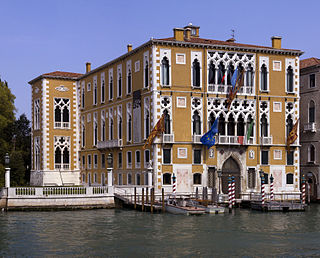
Palazzo Cavalli-Franchetti is a palace in Venice, Italy, not far from the Ponte dell'Accademia and next to the Palazzo Barbaro on the Grand Canal of Venice. The palace was erected in 1565 by the patrician Marcello family, later passing to the Gussoni. In the 19th century it was internally modernised and externally enriched in revived Venetian Gothic style, with rich window framing, by a series of grand owners.

The Palazzo Dario is a palace located between the Palazzo Barbaro Wolkoff and the narrow Rio delle Torreselle on the Grand Canal in the sestiere of Dorsoduro, of the city of Venice, Italy. The palace was built in the Venetian Gothic style and was renovated in Renaissance style.
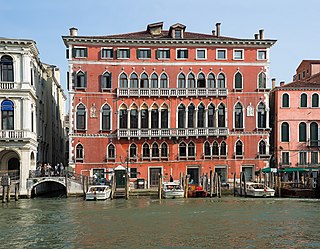
Palazzo Bembo is a palace in Venice, Italy, on the Grand Canal, close by the Rialto Bridge and next to the Palazzo Dolfin Manin.

Palazzo Corner della Ca' Granda, also called Ca' Corner della Ca' Granda or simply Palazzo Corner or Palazzo Cornaro, is a Renaissance-style palace located between the Casina delle Rose and the Rio di San Maurizio (Venice), across the Grand Canal from the Palazzo Venier dei Leoni, in the city of Venice, Italy. It is the current seat of the province of Venice and of the city's prefect.
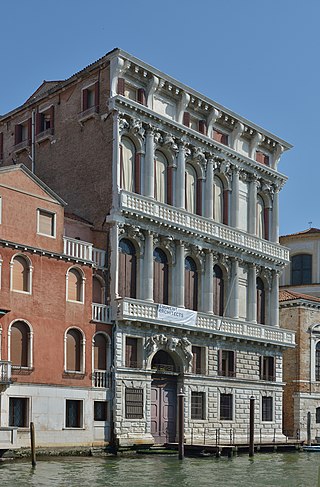
The Palazzo Flangini is a Baroque style palace on the Grand Canal, located adjacent to Campo San Geremia in the sestiere of Cannaregio in Venice, Italy.

The Palazzo Ferro Fini is a historical building in Venice, Italy. It was originally two buildings, the Palazzo Morosini Ferro and the Palazzo Flangini Fini, which were combined into one in the 1860s to create the luxury Hotel New York. The hotel was occupied by troops in World War II (1939–45). By 1970 the hotel was in decay, and the building was purchased by the Veneto region, which undertook extensive renovations and made it the seat of the regional council.

The Palazzo Michiel Dalle Colonne is a Baroque style palace located on the northern bank of the Grand Canal in the sestiere of Cannaregio in Venice, Italy. It is one building south of the junction of Rio del Santissimi Apostoli with Grand Canal, next to the Palazzo Michiel del Brusà and across the Canal from the Rialto Mercato and the Campo della Pescaria. The palace is also referred to as Palazzo Michiel Dalle Colonne a Santa Sofia.

The Palazzo Papadopoli is a Baroque-style palace located on the Canal Grande of Venice, between Palazzo Giustinian Businello and Palazzo Donà a Sant'Aponal in the Sestiere of San Polo, Venice, Italy. The opposite building is the Palazzo Corner Contarini dei Cavalli.

Palazzo Ariani, also known as Palazzo Ariani Minotto Cicogna, is a palace in Venice, located in the Dorsoduro district, almost opposite to the church of Angelo San Raffaele and not far from San Sebastiano. The nearby bridge Ponte del Soccorso connects it to the Palazzo Zenobio.
References
- ↑ Venipedia article.
- ↑ XXIV Quattro Palazzi di Venezia Archivio veneto: pubblicazione periodica, Volumes 5-6 page 327-328.
- ↑ The Rough Guide to Venice & the Veneto, by Jonathan Buckley.
45°26′35″N12°19′31″E / 45.44296°N 12.32536°E